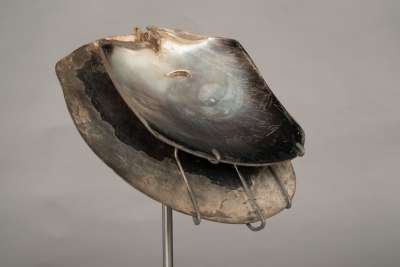Clapper
Acquired by 1st Lieutenant Francis Godolphin Bond on the HMS Providence, which arrived in Matavai Bay, Tahiti, on 9 April 1792. Bond donated this costume to the Devon and Exeter Institution in 1815, of which he was a proprietor. This gift was recorded in the D&EI committee meeting minutes. The Devon & Exeter Institution presented this costume to the Albert Memorial Museum in 1872.
A Tahitian chief possessed great social status but also charged with great spiritual power called mana. Upon the death of a chief their body was treated accordingly and mounted on biers shrouded in fine white barkcloth. Relatives would gather around the bier and mourn.
A senior relative would appear in a mourner’s costume (heva tupapa’u) to lead a spectacular procession, accompanied by family members with their skins blackened with soot. Pearl-shell clappers would warn people as the procession approached to withdraw or conceal themselves. Otherwise they could face being attacked or injured with a sword edged with shark teeth.
Larger shell = 200 x 170mm
Anne D’Alleve, 1994
“Large pearly shell to which a smaller pearl shell has been attached with barkcloth strips threaded through drill holes. Large shell is round; smaller is shaped, with two straight sides.”
Donated by Devon & Exeter Institution in 1872 but incorrectly described in museum register as ‘shells for scraping bark’.
A Tahitian chief possessed great social status but also charged with great spiritual power called mana. Upon the death of a chief their body was treated accordingly and mounted on biers shrouded in fine white barkcloth. Relatives would gather around the bier and mourn.
A senior relative would appear in a mourner’s costume (heva tupapa’u) to lead a spectacular procession, accompanied by family members with their skins blackened with soot. Pearl-shell clappers would warn people as the procession approached to withdraw or conceal themselves. Otherwise they could face being attacked or injured with a sword edged with shark teeth.
Larger shell = 200 x 170mm
Anne D’Alleve, 1994
“Large pearly shell to which a smaller pearl shell has been attached with barkcloth strips threaded through drill holes. Large shell is round; smaller is shaped, with two straight sides.”
Donated by Devon & Exeter Institution in 1872 but incorrectly described in museum register as ‘shells for scraping bark’.
Object Summary
- Accession Loan No.
- E1742
- Category
- Ethnography
- Collection Class
- Musical instruments
- Collection Area Region
- POLYN
- Material
- pearl shellbark cloth
- Common Name
- clapper
- Simple Name
- clapper
- Production County
- Tahiti, Society Islands
- Production Country
- French Polynesia (Overseas Collectivity of France)
- Production Year High
- 1792


